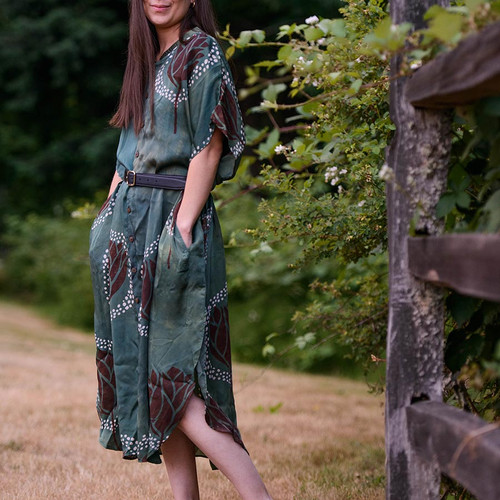Why Don't Women's Clothes Have Pockets?
Posted by The Ichcha Team on 13th Jun 2025
Table of Contents
- History of Pockets in Women’s Clothes
- Pocketless Women’s Clothes - A Case of Gender Inequality
- When Did Women Start Having Pockets?
- Ichcha – Find Women’s Clothes with Pockets
As a woman, ever been on a casual stroll and felt a sudden need to relax your hands into your dress pockets only to realize they're non-existent? Or maybe you reached for your jeans pockets, and alas! They're either too tiny to be functional or are a mere decorative stitch.
As a woman, there are times I want to dump my handbag at home, squeeze my mobile, keys, and a few other items into my pocket, and hit the road. But boy, is this a challenge because women's clothes hardly ever come with pockets!
Buy why?
Why don't women's clothes have pockets?
Some argue that the reason women's clothes usually lack pockets is because of the handbag industry. Well, is that really the case?
While the absence of pockets in women's clothing can seem like a tiny detail, it's rooted deeply in history as a patriarchal tool for enforcing gender inequality. Women's clothes are often designed without pockets to restrict the wearer's agency and autonomy.
To explain that, let's time-travel to 700 years ago.
History of Pockets in Women’s Clothes

During the 14th century, the basic women’s undergarment was the linen smock, worn night and day. They'll then wear a kirtle or gown over it. They used a belt to cinch the waist and create shape, and items like handkerchiefs and tools were tucked into this belt. An overtunic is then worn over the gown. The overtunic had openings to allow access to the items. This overtunic basically hid the purse and items from view as the woman went about her day hands-free.
The point?
Despite wearing dresses designed without pockets, these 14th-century women felt the need to improvise by tucking items discreetly within their dresses.
Even the 18th century understood the need for pockets. Ever heard the nursery rhyme "Lucy Locket lost her pocket"?
How can someone lose their pocket? Well, it so happened that in the 18th century, women's dresses were still tailored without pockets. Needing somewhere to keep their items, the 18th-century woman would sew an external pocket and tie it with ribbon around the waist (it could fall off and get lost like Lucy’s). Like in the 14th century, the pockets remained hidden within the dress, beneath the petticoat.
Women’s clothing today has evolved. But despite all the pretty improvements, a usable pocket is one tiny detail fashion brands continue to forget.
Or is it mere forgetfulness?
The famous designer, Christian Dior, answered this question with his 1954 quote, "Men have pockets to keep things in, women for decoration." This explains the presence of stitching where a functional pocket should have been.
It could be said that tailors design women's clothes without pockets because the feminine outfit prides itself on smooth silhouettes. Stacking a pocket with bulging items might compromise the smooth curves that otherwise would have been accentuated.
But hold on. It goes deeper than that.
Pocketless Women’s Clothes - A Case of Gender Inequality

Even while women’s clothes were sewn without pockets, this same detail has always been a typical feature in men's clothing, as they were considered the independent gender: they took the coins, keys, and documents in their pockets as they went to the fields. Whereas women were expected to stay home and focus on appearance rather than function.
Why is this a big deal?
You see, clothing as a technology should enable the wearer to act, but it does the opposite for women as it restricts their movement and agency.
You can agree that clothing — or fashion — is a means for expressing identity. Your identity reflects in what you wear. In reverse, what you wear influences how you present yourself, or how you feel about yourself. The functionality of your clothing also matters, as it influences the extent to which you can move or act.
Drawing from this logic, garments with pockets bestow upon the wearer profound agency, allowing them to carry tools, gadgets, and items with which they can both survive and actively impact their environment.
Now ask yourself, if all humans are considered equal with the same freedom of expression and agency, why then are men afforded pockets but women are denied?
If clothing can influence how you feel about yourself, and clothes with functional pockets make you feel autonomous, confident, and powerful, does it not follow that clothes without pockets will make you feel the opposite?
It's easy to move about when all you need can fit into your garment. Credit card, handkerchief, smartphone, name it. Although handbags make you more stylish, consider the tradeoff when you just want to be casual.
Maybe all of that is by design?
I cannot say.
What I can say is, clothing influences gender identity.
The absence of pockets in women's clothes can be attributed to societal anxieties about disrupting established gender roles. Granting women the same freedom and agency as men with usable pockets may blur the line between their gender identities, challenging male privileges and societal norms.
Whether consciously, subconsciously, or by social engineering, it appears that women’s clothes are designed without pockets in order to subtly deny them this male privilege of agency and autonomy.
After all, pockets in Victorian literature and culture were associated with masculine authority, property ownership, and privacy, highlighting the gendered meaning of clothing.
Fashion has come a long way. Women now wear pants, shirts, and hoodies once deemed male-ish. But this seemingly tiny detail—pockets—often remain absent. And that's quite questionable.
Fun fact: In the days of old, petticoats and corsets were made by men, as women were not considered strong enough to manipulate the boning materials needed to create hoops and corsets.

Just as corsets gave Victorian women deformed rib cages at the expense of enhanced feminine form, and modern revealing clothing heightens seduction but limits movement (you move less to prevent wardrobe malfunction), so does women's clothing without pockets enhance silhouettes but stifles agency. And hence identity.
Within these lines lies a pattern.
When Did Women Start Having Pockets?
Women's clothes started having Integrated pockets in the 1880s and 1890s, replacing tie-on pockets. (Tie on pockets, aka Lucy Locket lost her pocket.)
Pockets in women's clothing started mostly in tailor-made suits in the 1890s, although these were more decorative than functional, as they were rather too small. But it was changing the narrative.
Today, pockets are a little more present -- although still a tad less functional -- than in the 17th century. But there's still a world of difference in how often you find women's clothes with pockets compared to men's.
Hop on X, Instagram, and TikTok, and you’ll find women aggressively searching and campaigning for proper pockets in their pants and dresses. The movement didn't start today. It goes back hundreds of years.
And we’re actively joining the fight.
Ichcha – Find Women’s Clothes with Pockets
At Ichcha, we've always believed it's every woman's right to have functional pockets in their clothes. Not just the stitched, decorative ones. That's why our dresses, shorts, pajamas, and even kimonos all have pockets.
We are a woman-owned brand and understand firsthand the frustration of not having a pocket you can dip your hands into or stash your keys, phone, and credit card when you just want to go hands-free. We are saying no to the systemic limitations imposed on women through fashion.
With our pocketed dresses, you can finally move hands-free.



